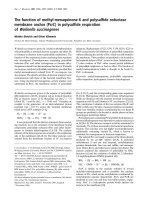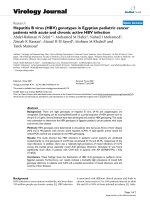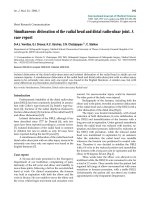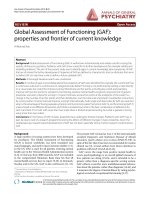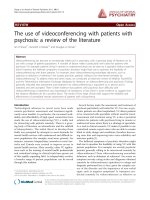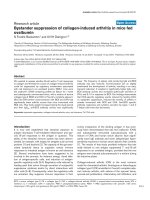Báo cáo y học: "Rare incidence of methotrexate-specific lesions in liver biopsy of patients with arthritis and elevated liver enzymes" potx
Bạn đang xem bản rút gọn của tài liệu. Xem và tải ngay bản đầy đủ của tài liệu tại đây (214.56 KB, 7 trang )
RESEARC H ARTIC LE Open Access
Rare incidence of methotrexate-specific lesions in
liver biopsy of patients with arthritis and elevated
liver enzymes
Emilie Quintin
1
, Jean-Yves Scoazec
2
, Hubert Marotte
1
, Pierre Miossec
1*
Abstract
Introduction: The present study objective was to evaluate the incidence of methotrexate (MTX)-specific liver
lesions from the analysis of a liver biopsy of inflammatory arthritis patients with elevated liver enzymes.
Methods: A case-control study was performed with 1,571 arthritis patients on long-term low-dose MTX therapy.
Results of liver biopsy were analyzed in 41 patients with elevated liver enzymes. The expression of autoimmune
markers was also assessed. This population was compared with 41 disease control subjects obtained from the
same database, also on MTX but without elevated liver enzymes, matched for age, sex and rheumatic disease.
Results: Compared with the disease controls, patients with liver biopsy showed lower disease duration and lower
MTX exposure, weekly and cumulative doses, reflecting shorter treatment duration due to liver abnormalities. Liver
biopsies showed 17 autoimmune hepatitis-like (AIH-like) lesions, 13 nonalcoholic steatohepatitis-like lesions, seven
limited liver lesions, and two primary biliary cirrhoses. However, MTX-specific lesio ns with dystrophic nuclei in
hepatocytes were seen in only two cases. Liver biopsy lesions were associated with autoimmune markers (P =
0.007); notably, AIH-like lesions were associated with rheumatoid arthritis and with the presence of the HLA-DR
shared epitope.
Conclusions: MTX-specific liver lesions are rarely observed in arthritis patients under long-term MTX therapy and
elevated liver enzymes.
Introduction
Low-dose methotrexate (MTX) has been used for the
treatment of inflammatory disorders since 1950. The
early observation that psoriatic arthritis responded to
MTX was followed by clinical trials in other inflamma-
tory diseases such as rheumatoid arthritis (RA), primary
Sjögren syndrome (pSS) and connective tissue diseases
(CTD) with a rather good safety profile [1]. Today, low-
dose MTX therapy is the most commonly used treat-
ment for rheumat ic disea ses [2]. Weekly low-dose MTX
treatment acts primarily as an anti-inflammatory drug,
specifically through the release of adenosine, rather than
as an anti-metabolite drug as in cancer [ 3,4]. Even at
low doses, MTX ha s been associ ated with hepatic disor-
ders, mostly elevated liver enzymes that may lead to
treatment cessation [5-7]. This association has led to the
publication of guidelines for the clinician [5,8,9].
In inflammatory arthritis patients on long-term low-
dose MTX, the contribution of the underlying rheumatic
disease has been incriminated in the genesis of these
liver lesions, with MTX a cting possibly as a cofactor
[10,11]; however, this is not fully demonstrated. A large
variety of histological liver lesions has been described,
including dystrophic nuclei, macrovesicular steatosis,
cell necrosis, cholestasis, Ito cell hyperplasia, portal
inflammation, liver fibrosis [12-14] and even cirrhosis
[15-17]. The severity of these lesions has been associated
with the duration of treatment in some conditions
[13,18]. Importantly, many of these lesions are observed
in the absence of MTX. Some cell changes with dys-
trophic nuclei in hepatocytes, however, are considered
the most MTX-specific lesions, but their real incidenc e
is not really known [15].
* Correspondence:
1
Clinical Immunology Unit, Departments of Immunology and Rheumatology,
Edouard Herriot hospital, Place d’Arsonval, 69437 Lyon, France
Quintin et al . Arthritis Research & Therapy 2010, 12:R143
/>© 2010 Quintin et al.; licensee BioMed Central Ltd. This is an open access article distributed under the t erms of the Creative Commons
Attribution License ( g/licenses/by/2.0), which permits unrestricted use, distribution, and repro duction in
any medium, provided the original work is properl y cited.
The present report aimed to assess the incidence of
the most MTX-specific lesions [15] and the contribution
of the underlying rheu matic disease in the development
of hepatic disorders in a large cohort of arthritis patients
on long-term low-dose MTX. Histological characteristics
of liver biopsies and biological autoimmune markers
from 41 arthritis patients with elevated liver enzymes
while on MTX treatment were analyzed.
Materials and methods
Patient inclusion criteria
Among 2,492 patients followed for chronic inflamma-
tory arthritis in o ur unit, a population of 1,571 patients
on long-term low-dose MTX therapy was studied. All
details regarding clinical features, treatment dosing and
laboratory follow-up were available from a single com-
puter database. Liver enzymes were followed every
month in all patients as part of th eir routine follow -up.
Forty-one patients with an increase of liver enzymes
(transaminases >3 upper limits of normal) for more
than 3 weeks after stopping MTX underwent a liver
biopsy. Transaminases were still elevated at the time of
biopsy. None had liver enzyme eleva tion at baseline
prior to starting MTX treatment. No other obvious liver
risk fact or was reported (alcohol consumption, obesity,
other obvious hepatotoxic drugs), except diabetes in
three patients. Patients positive for hepatitis B and hepa-
titis C were excluded. For each subject, age, disease
duration, MTX exposure duration, MTX weekly doses
and MTX cu mulative doses were r ecorded, as well as
biological markers linked to aut oimmunity - including
rheumatoid factor, anti-cyclic citrulli nated peptide (anti-
CCP) antibodies, antinuclear antibodies, anti-DNA antibo-
dies, anti-smooth muscle antibodies ( SMA), liver kidney
microsomal type 1 (LKM1) antibodies, anti-mitochondrial
antibodies, HLA-DR shared epitope (HLA-DRB1*0401,
HLA-DRB1*0404, HLA-DRB1*04 05, HLA-DRB1*0408,
HLA-DRB1*0101, HLA-DRB1*01 02, HLA-DRB1*1001,
HLA-DRB1*1402), HLA-B27 and HLA-DRB1*03.
To compare the populations with and without liver
disease, the patients with liver biopsy were compared
with a population of 41 arthritis patients o btained from
the same database of 1,571 patients also on MTX ther-
apy but without elevated liver enzymes on their monthly
follow-up, exactly matched for age, sex, and type of
inflammatory disease. The protocol was approved by the
ethical committee for clinical research of the University
Hospitals of Lyon and of the French Minist ries of
Health and of Research, and all patients gave their
informed written consent.
Patients and disease controls were split into four
groups according to the main associated chronic inflam-
matory arthritis: RA, according to the American College
of Rheumatology criteria [19]; spondylarthropathy
(SpA), according t o the European Spondylarthropathy
Study Group criteria, including ankylosing spondylitis
and psoriatic arthritis [20]; pSS, according to the Eur-
opean revised criteria [21]; and CTD, including systemic
lupus erythematosus and mixed CTD.
Analysis of liver biopsy
The analysis focused on the histological findings of an
echo-guided liver biopsy performed in 41 patients. No
immediate or secondary event was noticed during and
after liver biopsy. Samples were of good quality (>15
mm long) and were fixed in buffered formalin and
embedded in paraffin. Four-micrometer tissue sections
were stained with hematoxylin and eosin, chromotrope,
Masson’s trichrome and Perls’ staining. All liver biopsies
were analyzed by the same pathologist (J-YS), unaware
of the clinical details other than the inclusion in the
protocol.
The following paramet ers were studied: portal inflam-
mation, graded from 0 to 3; lobular inflammation,
graded from 0 to 3; composition of the inflammatory
infil trates, especially the presence of plasma cells and/or
eosinophils; presence, extent and distribution of hepato-
cellular necrosis; presence, extent and distribution of
fibrosis as periportal, perisinusoidal and centrolobular;
presence of dystrophic nuclei in hepatocytes, which has
been previously linked to direct MTX liver toxicity [15];
presence, extent and distribution of steatosis; and other
lesions (biliary alterations, vascular changes, and so
forth).
Statistical analysis
Analysis of variance was performed to test the effect of
diagnostic group and type of biopsy finding on mean
age, disease duration, MTX exposure, cumulative and
weekly doses using the SygmaStat® statistical analysis
software (Systat software, Chicago, IL, USA). The signifi-
cant analysis of variance results were adjusted by post-
hoc Bonferroni t test. The chi-square test was carried
out to test the association between groups and autoim-
mune marker expression. Statistical comparisons
between patients and disease c ontrols used the Student
t test or the Mann-Whitney rank sum test when the test
for normality failed. All values are presented as the
mean ± standard error of the mean. P < 0.05 was con-
sidered significant.
Results
Patient population
Forty-one patients out of a total population of 1,571
arthritis patients on MTX treatment and with elevated
liver enzymes underwent a liver biopsy (2.6%), and were
compared with 41 disease control subjects without
elevated liver enzyme, matched for age, sex, and
Quintin et al . Arthritis Research & Therapy 2010, 12:R143
/>Page 2 of 7
inflammatory disease. For obvious practical and ethical
reasons, the control population was not exposed to the
potential risk of a liver biopsy.
Statistical comparisons showed no difference between
the two groups, except for lower mean values for disease
duration (P = 0.01), for MTX exposure duration (P <
0.001), and for MTX cumulative dose (P <0.001)inthe
patients with liver biopsy compared with their disease
controls (for details, see Table 1). These results reflect
an earlier termination of MTX in biopsied patients
because of hepatic toxicity.
When considering the population of 41 patients with
liver biopsy, the distribution of the rheumatic diseases
was as follows: 25 RA cases, eight SpA cases (including
four ankylosing spondylitis and four psoriatic arthritis),
six pSS cases and two CTD cases (including one sys-
temic lupus erythematosus and one mixed CTD). These
groups of patients significantly differed only by their
mean ag e (P = 0.01) but not by either disease duration,
MTX exposure duration, or cumulative or weekly dose
mean values (data not shown). There was an expected
link between the rheumatic disease and the expression
of autoimmune markers. The presence of rheumatoid
factor, anti-CCP antibodies and the HLA-DR shared epi-
tope was mostly repor ted with RA patients. No signifi-
cant association was observed between the rheumatic
disease and the other autoimmune markers such as anti-
nuclear antibodies, anti-DNA antibodies, and presence
of HLA-B27 or HLA-DRB1*03.
Histological findings of liver biopsies
The histological findings of liver biopsies showed a spec-
trum of lesions, which could for clarity be divided into
five groups (Table 2). The most common liver lesions
were autoimmune hepatitis-like (AIH-like) lesions,
found in 17/41 patients (41.5%). These lesions were
characterized by the presence of portal and/or lobular
inflammatory infiltrates, usually rich in plasma cell s,
associated with hepatocellular necrosis (piecemeal
necrosis or intralobular necrosis). These lesions were
usually mild and t he necrotic-inflammatory activity was
mild to moderate, and only a limited amount of fibrosi s
was usually present. If present, steatosis was usually
mild. There was no evidence of dystrophic nuclei to
suggest a direct MTX toxicity [15].
The second most common liver lesions were nonalco-
holic steatohepatitis (NASH) lesions found in 13/41
patients (31.7%). These lesions were characterized by
marked macrovesicular steatosis (in more than 30% of
hepatocytes), glycogen-ladennucleiandhepatocellular
ballooning. Minimal inflammation might be present.
Fibrosis, when present, was mainly perisinusoidal and
predominated into the centrilobular areas.
The th ird pattern was limited liver lesio ns, reported in
7/41 patients (17%), consisting of mild portal or lobular
inflammatory infiltrates, with no or limited evidence of
hepatocellular fibrosis. The overall hi stological picture
waspoorlyspecificandthelesionswerenotclear
enough to be classified as part of another group.
In two cases (4.9%), primary biliary cirrhosi s (PBC)
fulfilling all histological criteria [22] was discovered in
these PBC-asymptomatic patients. Both cases were nega-
tive for antimitochondrial antibodies. These lesions were
detected only because the patients were on MTX w ith
monthly liver enzyme determinations.
Finally, lesions directly related to the hepatic toxic
effects of MTX were reported in only two cases (4.9%).
The lesions combined steatosis, hepatocytes w ith dys-
trophic nuclei and extensive perisinu soidal fibrosis, with
no or very limited inflammation [15]. The specific con-
tribution of the drug, despite a similar exposure to
MTX in the 41 patients, could therefore be demon-
strated in a very limited number of cases.
It is to be noted that nonextensive lesions of fibrosis
were observed in 11 out of 17 AIH-like lesions (65%), in
eight out of 13 NASH-like lesions (61.5%) and in the
Table 1 Characteristics of patients with liver biopsy and of disease control patients
Patients with liver biopsy Disease control patients P values
Sex (female/male) 28/13 28/13 NS
Age (years) 52.2 ± 1.9 52.4 ± 1.9 NS
Rheumatic disease 25 RA; 8 SpA; 6 pSS; 2 CTD 25 RA; 8 SpA; 6 pSS; 2 CTD NS
Disease duration (years) 7.4 ± 1.1 10.5 ± 1.1 0.01
MTX exposure (weeks) 131.6 ± 26 277.9 ± 29.6 <0.001
MTX cumulative dose (mg) 1,287.8 ± 246.7 3,217.3 ± 368 <0.001
MTX weekly dose (mg/week) 10.9 ± 0.7 12.240 ± 0.7 NS
Shared epitope positivity 17/36 22/41 NS
Rheumatoid factor positivity 17/38 19/39 NS
Anti-CCP positivity 19/29 12/23 NS
Data for 41 patients with liver biopsy compared with 41 subjects matched for age, sex and rheumatic disease from a population of 1,571 arthritis patients on
long-term methotrexate (MTX) therapy. Data presented as n or mean ± standard error of the mean. CCP, cyclic citrullinated peptide; CTD, connective tissue
disease; NS, not significant; pSS, primary Sjögren syndrome; RA, rheumatoid arthritis; SpA, spondylarthropathy.
Quintin et al . Arthritis Research & Therapy 2010, 12:R143
/>Page 3 of 7
two cases of PBC, and were not observed in limited liver
lesions (P = 0.01).
Associations between histological lesions and biological
markers
As shown in Table 3, the MTX exposure duration and
cumulative or weekly doses did not differ between
groups of histological lesions. On t he other hand, there
was a link between the histological lesions and the
underlying rheumatic disease (P =0.04).AIH-like
lesions were mostly seen in RA patients (13 out of 25
RA patients; 52.5%), in two out of eight patients with
SpA (25%), in two out of two patients with CTD and
not in patients with pSS. NASH-like lesions were
observed in nine out of 25 RA patients (36%), in three
out of eight patients with SpA (37.5%), in one out of six
patients with pSS (16.7%) and not in patients with CTD.
Limited liver lesions were found in one out of 25 RA
patients (4%), in two out of eight patients with SpA
(25%), in four out of six patients i n pSS (66.7%) and not
in patients with CTD. PBC was observed in o ne out of
25 RA patients (4%), in one out of six patients with pSS
(16.7%) and not in patients with SpA or CTD. Liver
lesions related to direct MTX toxicity were found in
only two cases, one in RA and the other in SpA (for
details, see Table 2).
Furthermore, there was an association between the
liver lesions and the shared epitope (P = 0.007). Given
that the liver lesions were found to be associated with
the underlying disease - specifically RA - and that RA is
associated with the shared epitope (for details, see ear-
lier Patient population), such an association was
expected. The shared epitope was mostly found in
patients with AIH-like lesions (12/15), and less in
patients with NASH-like lesions (4/12). No significant
association was observed between a particular histologi-
cal lesion and the other autoimmune markers such as
rheumatoid factor, anti-CCP, antinuclear antibodies,
anti-DNA, anti-SMA, anti-mitochondrial antibodies,
anti-LKM1 antibodies, HLA-B27 and HLA-DRB1*03
Table 2 Distribution of the histological liver lesions depending on the associated rheumatic disease
AIH-like lesions NASH-like lesions Limited liver lesions PBC Direct MTX toxicity Total
Rheumatoid arthritis 13 (31.7%) 9 (22%) 1 (2.4%) 1 (2.4%) 1 (2.4%) 25 (61%)
Spondylarthropathy 2 (4.9%) 3 (7.3%) 2 (4.9%) 0 (0%) 1 (2.4%) 8 (19.5%)
Primary Sjögren syndrome 0 (0%) 1 (2.4%) 4 (9.8%) 1 (2.4%) 0 (0%) 6 (14.6%)
Connective tissue disease 2 (4.9%) 0 (0%) 0 (0%) 0 (0%) 0 (0%) 2 (4.9%)
17 (41.5%) 13 (31.7%) 7 (17%) 2 (4.9%) 2 (4.9%) 41 (100%)
Data presented as n (%). AIH, autoimmune hepatitis; MTX, methotrexate; NASH, nonalcoholic steatohepatitis; PBC, primary biliary cirrhosis.
Table 3 Characteristics of the patients with liver biopsy depending on the histological liver lesions
AIH-like lesions
(n = 17)
NASH-like lesions
(n = 13)
LL lesions
(n =7)
PBC (n = 2) Direct MTX toxicity
(n =2)
P value
Sex (female/male) 13/4 8/5 5/2 2/0 0/2 NS
Age (years) 55.2 ± 3.2 51.2 ± 3.2 47.7 ± 4.5 57.5 ± 6.5 44.5 ± 1.5 NS
Disease duration (years) 10.5 ± 2.2 5.2 ± 1.1 4.6 ± 1.8 6.2 ± 1.8 6.9 ± 4.9 NS
MTX exposure (weeks) 139.9 ± 44.8 132.8 ± 33.8 26.1 ± 7.2 227.6 ± 158.2 325.7 ± 282.9 NS
MTX cumulative dose (mg) 1,260.9 ± 324.3 1,458.4 ± 460.9 306.1 ± 77 1,676.9 ± 1,156.9 3,454.2 ± 3,025.7 NS
MTX weekly dose (mg/week) 10.2 ± 1.7 12 ± 1.3 11.6 ± 1.6 7.4 ± 0.1 10.3 ± 0.3 NS
Patients on steroid 7/17 4/13 1/7 0/2 0/2 NS
Fibrosis 11/17 8/13 0/7 2/2 2/2 0.01
Shared epitope positivity 12/15 4/12 1/7 0/2 ND 0.01
HLA-B27 positivity 3/15 1/12 2/7 0/2 ND NS
HLA-DRB1*03 positivity 1/15 2/12 2/7 1/2 ND NS
Rheumatoid factor positivity 8/15 6/12 2/7 0/2 1/2 NS
Anti-CCP positivity 14/16 5/9 0/2 0/1 0/1 0.01
ANA positivity 10/16 4/13 2/7 2/2 1/2 NS
Anti-DNA antibody positivity 2/15 0/13 2/7 0/2 0/2 NS
Anti-SMA positivity 2/12 0/9 1/7 0/2 0/2 NS
Anti-LKM1, positivity 0/12 0/9 0/7 0/2 0/2 ND
AMA positivity 2/12 0/9 0/7 1/2 0/2 NS
Data presented as n or mean ± standard error of the mean. AIH, autoimmune hepatitis; AMA, antimitochondrial antibodies; ANA, antinuclear antibodies; CCP,
cyclic citrullinated peptide; LKM1, liver/kidney microsomal antibodies type 1; LL, limited liver; MTX, methotrexate; NASH, nonalcoholic steatohepatitis; ND, not
determined; NS, not significant; PBC, primary biliary cirrhosis; SMA, smooth muscle antibodies.
Quintin et al . Arthritis Research & Therapy 2010, 12:R143
/>Page 4 of 7
(Table 3). In addition, patients with AIH-like lesions
were mostly negative for the antibodies commonly
found in auto immune hepatitis (anti-SMA or anti-
LKM1 antibodies [23]), suggesting a particular entity.
Discussion
An increase of liver enzymes is the most common
adverse event observed in clinical practice in arthritis
patients under long-term MTX therapy; h owever, the
exact mechanism of s uch disorder remains unclear.
Combining histological and immunological approaches,
the present study indicated that the direct role of long-
term low-dose MTX in the genesis of a MTX-specific
liver change with dystrophic nuclei in hepatocytes was
very rarely observed. In contrast, autoimmune lesions
were commonly found.
Previous results have suggested a poor correlation
between the level of increase of liver enzymes and histo-
logical findings on liver biopsies in arthriti s patients
under long-term MTX therapy [1 5-17,24,25]. In post-
mortem liver biopsies performed on 188 subjects with
RA on long-term low-dose MTX therapy, Ruderman
and colleagues reported only two cases of hepatic fibro-
sis, which were not directly related to MTX but related
to either chronic alcoholism or chronic viral hepatitis
[26]. R ichard and colleagues performed systematic liver
biopsies prior to the introduction of long-course low-
dose MTX and after 1 year of therapy. Eleven cases of
hepatic fibrosis were observed prior to the introduction
of MTX, with no sign of worsening at 1 year [27]. More
recently, no correlation was found between liver MTX
concentrations and incidence of liver toxicity [28]. Based
on these results, liver biopsy is no longer performed on
a systematic basis after exposure to usually 2 g MTX.
In the present study, histological findings with dys-
trophic nuclei consistent with a direct MTX toxicity
[15] were found in only two patients. These changes are
not found with nonsteroidal anti-inflammatory drug
therapy, the dr ugs most commonly found in associatio n
with MTX. It should be noticed that NASH-like lesions
were not associated with fibrosis and dystrophic nuclei.
As such, they were not classified as MTX-related
because of the absence of the last two parameters.
These isolated liver changes could result from a large
number of causes, i ncluding systemic inflammation
itself, metabolic abnormalities, namely diabetes, and
alcohol intake. In the other changes, the heterogeneity
of the histological lesions (that is, mainl y AIH-like and
NASH-like) and the fact that none of these appear ed as
MTX dose-dependent suggest a poor link between these
liver lesions and MTX administration. This conclusion
is in contrast with prev ious but older studies that con-
cluded a need to perform sequential liver biopsies to
detect direct MTX liver toxicity [18,29]. The current
recommend ations do not re ach the same conclusion [8].
In our study, neither NASH-like lesions nor the other
histological lesions appeared MTX dose-dependent, con-
sistent with previous data [30,31] . These results are in
favor of a weak direct liver toxicity of long-term MTX
in arthritis patients. We reached the same conclusion on
safety in patients with arthritis and hepatitis C treated
with MTX or etanercept [32,33].
Interestingly, a link between the histological liver
lesions and the underlying rheumatic disease was
observed. The association between autoimmune rheu-
matic disease and hepatic lesions has been previously
reported. In our study, AIH-like lesions were strongly
associated with RA and with the presence of the
shared epitope. An interesting and new observation is
that the presence of the antibodies commonly found in
AIH (anti-SMA and anti-LKM1 antibodies [23]) was
mostly negative in these RA-associated AIH-like
lesions. The reason for this observation is unclear but
could be linked to the rather modest intensity of the
lesions. On the other hand, anti-CCP antibodies, also
described in type 1 autoimmune hepatitis, were
observed in almost 90% of patients with AIH-like
lesions.
Overall, the results of the present study lead one to
reconsider the role of autoimmunity in the induction of
hepatic disorders in arthritis patients under long-term
low-dose MTX therapy. Indeed, in these patients, ele-
vated liver enzymes were rarely the consequence of
direct MTX toxic effects. The presence of an underlying
latent liver disease, possibly autoimmune in nature, was
commonly found - especially in RA patients. In this par-
ticular context, exact causality assessment i n drug-
related liver injury remains a difficult challenge, even
using the new criteria [34]. To assess the real influence
of autoimmune mechanisms in the genesis of hepatic
disorders in arthritis patients on MTX treatment, it
would be necessary to perform a prospective study with
liver biopsy both before the introduction of MTX and
during treatment in control patients without elevated
liver enzymes. Today, such an approach is difficult -
even impossible - to follow from an ethical point of
view.
Conclusions
MTX-specific liver lesions are rarely found in arthritis
patients. A n early increase of liver e nzymes should not
lead systematically to stopping MTX treatment. Liver
biopsy remains of interest to diagnose independent or
poo rly related liver lesions. This technique may identify
a latent autoimmune liver disease, possibly related to
persistent activity of the inflammatory disease. Other
modes of treatment including cytokine inhibitors could
be indicated in this context.
Quintin et al . Arthritis Research & Therapy 2010, 12:R143
/>Page 5 of 7
Abbreviations
AIH: autoimmune hepatitis; CCP: cyclic citrullinated peptide; CTD: connective
tissue diseases; LKM1: liver/kidney microsomal type 1 antibodies; MTX:
methotrexate; NASH: nonalcoholic steatohepatitis; PBC: primary biliary
cirrhosis; PSS: primary Sjögren syndrome; RA: rheumatoid arthritis; SMA:
smooth muscle antibodies; SPA: spondylarthropathy.
Author details
1
Clinical Immunology Unit, Departments of Immunology and Rheumatology,
Edouard Herriot hospital, Place d’Arsonval, 69437 Lyon, France.
2
Department
of Pathology, Edouard Herriot hospital, Place d’Arsonval, 69437, Lyon, France.
Authors’ contributions
EQ participated in the design of the study, collected the data, performed
the statistical analysis, and drafted the manuscript. J-YS performe d the
analysis of the liver biopsies. HM contributed to the follow-up of patients
and to data collection. PM participated in drafting and editing the
manuscript and is responsible for this manuscript. All authors read and
approved the final manuscript.
Competing interests
The authors declare that they have no competing interests.
Received: 26 October 2009 Revised: 25 May 2010
Accepted: 16 July 2010 Published: 16 July 2010
References
1. Ahern MJ, Smith MD, Roberts-Thomson PJ: Methotrexate hepatotoxicity:
what is the evidence? Inflamm Res 1998, 47:148-151.
2. Weinblatt ME, Coblyn JS, Fox DA, Fraser PA, Holdsworth DE, Glass DN,
Trentham DE: Efficacy of low-dose methotrexate in rheumatoid arthritis.
N Engl J Med 1985, 312:818-822.
3. Chan ES, Cronstein BN: Molecular action of methotrexate in inflammatory
diseases. Arthritis Res 2002, 4:266-273.
4. Cronstein BN, Naime D, Ostad E: The antiinflammatory mechanism of
methotrexate. Increased adenosine release at inflamed sites diminishes
leukocyte accumulation in an in vivo model of inflammation. J Clin Invest
1993, 92:2675-2682.
5. Kremer JM, Alarcon GS, Lightfoot RW Jr, Willkens RF, Furst DE, Williams HJ,
Dent PB, Weinblatt ME: Methotrexate for rheumatoid arthritis. Suggested
guidelines for monitoring liver toxicity. American College of
Rheumatology. Arthritis Rheum 1994, 37:316-328.
6. Salliot C, van der Heijde D: Long-term safety of methotrexate
monotherapy in patients with rheumatoid arthritis: a systematic
literature research. Ann Rheum Dis 2009, 68:1100-1104.
7. Visser K, van der Heijde DM: Risk and management of liver toxicity during
methotrexate treatment in rheumatoid and psoriatic arthritis: a
systematic review of the literature. Clin Exp Rheumatol 2009, 27:1017-1025.
8. Visser K, Katchamart W, Loza E, Martinez-Lopez JA, Salliot C, Trudeau J,
Bombardier C, Carmona L, van der Heijde D, Bijlsma JW, Boumpas DT,
Canhao H, Edwards CJ, Hamuryudan V, Kvien TK, Leeb BF, Martin-Mola EM,
Mielants H, Muller-Ladner U, Murphy G, Ostergaard M, Pereira IA, Ramos-
Remus C, Valentini G, Zochling J, Dougados M: Multinational evidence-
based recommendations for the use of methotrexate in rheumatic
disorders with a focus on rheumatoid arthritis: integrating systematic
literature research and expert opinion of a broad international panel of
rheumatologists in the 3E Initiative. Ann Rheum Dis 2009, 68:1086-1093.
9. Kremer JM: Therapy: methotrexate guidelines: compromise to reach
consensus. Nat Rev Rheumatol 2009, 5:186-187.
10. Matsumoto T, Kobayashi S, Shimizu H, Nakajima M, Watanabe S, Kitami N,
Sato N, Abe H, Aoki Y, Hoshi T, Hashimoto H: The liver in collagen
diseases: pathologic study of 160 cases with particular reference to
hepatic arteritis, primary biliary cirrhosis, autoimmune hepatitis and
nodular regenerative hyperplasia of the liver. Liver 2000, 20:366-373.
11. Abraham S, Begum S, Isenberg D: Hepatic manifestations of autoimmune
rheumatic diseases. Ann Rheum Dis 2004, 63:123-129.
12. Bjorkman DJ, Hammond EH, Lee RG, Clegg DO, Tolman KG: Hepatic
ultrastructure after methotrexate therapy for rheumatoid arthritis.
Arthritis Rheum 1988, 31:1465-1472.
13. Dahl MG, Gregory MM, Scheuer PJ: Methotrexate hepatotoxicity in psoriasis -
comparison of different dose regimens. Br Med J 1972, 1:654-656.
14. Kremer JM, Kaye GI, Kaye NW, Ishak KG, Axiotis CA: Light and electron
microscopic analysis of sequential liver biopsy samples from rheumatoid
arthritis patients receiving long-term methotrexate therapy. Followup
over long treatment intervals and correlation with clinical and
laboratory variables. Arthritis Rheum 1995, 38:1194-1203.
15. Zachariae H, Kragballe K, Sogaard H: Methotrexate induced liver cirrhosis.
Studies including serial liver biopsies during continued treatment. Br J
Dermatol 1980, 102:407-412.
16. Muller SA, Farrow GM, Martalock DL: Cirrhosis caused by methotrexate in
the treatment of psoriasis. Arch Dermatol 1969, 100:523-530.
17. Nyfors A: Liver biopsies from psoriatics related to methotrexate therapy.
3. Findings in post-methotrexate liver biopsies from 160 psoriatics. Acta
Pathol Microbiol Scand [A] 1977, 85:511-518.
18. Whiting-O’Keefe QE, Fye KH, Sack KD: Methotrexate and histologic hepatic
abnormalities: a meta-analysis. Am J Med 1991, 90:711-716.
19. Arnett FC, Edworthy SM, Bloch DA, Mcshane DJ, Fries JE, Cooper NS,
Healey LA, Kaplan SR, Liang MH, Luthra HS, Medsger TA, Mitchell DM,
Neustadt DH, Pinals RS, Schaller JG, Sharp JT, Wilder RL, Hunder GG: The
American Rheumatism Association 1987 revised criteria for the
classification of rheumatoid arthritis. Arthritis Rheum 1988, 31:315-324.
20. Amor B, Dougados M, Listrat V, Menkes CJ, Dubost JJ, Roux H,
Benhamou C, Blotman F, Pattin S, Paolaggi JB, et al: Evaluation of the
Amor criteria for spondylarthropathies and European
Spondylarthropathy Study Group (ESSG). A cross-sectional analysis of
2,228 patients. Ann Med Interne (Paris) 1991, 142:85-89.
21. Vitali C, Bombardieri S, Moutsopoulos HM, Coll J, Gerli R, Hatron PY, Kater L,
Konttinen YT, Manthorpe R, Meyer O, Mosca M, Ostuni P, Pellerito RA,
Pennec Y, Porter SR, Richards A, Sauvezie B, Schiodt M, Sciuto M,
Shoenfeld Y, Skopouli FN, Smolen JS, Soromenho F, Tishler M, Wattiaux MJ:
Assessment of the European classification criteria for Sjogren’s
syndrome in a series of clinically defined cases: results of a prospective
multicentre study. The European Study Group on Diagnostic Criteria for
Sjogren’s Syndrome. Ann Rheum Dis 1996, 55:116-121.
22. Leuschner U: Primary biliary cirrhosis presentation and diagnosis. Clin
Liver Dis 2003, 7:741-758.
23. Czaja AJ, Freese DK: Diagnosis and treatment of autoimmune hepatitis.
Hepatology 2002, 36:479-497.
24. Kremer JM: Not yet time to change the guidelines for monitoring
methotrexate liver toxicity: they have served us well. J Rheumatol 2002,
29:1590-1592.
25. Tobias H, Auerbach R: Hepatotoxicity of long-term methotrexate therapy
for psoriasis. Arch Intern Med 1973, 132:391-396.
26. Ruderman EM, Crawford JM, Maier A, Liu JJ, Gravallese EM, Weinblatt ME:
Histologic liver abnormalities in an autopsy series of patients with
rheumatoid arthritis. Br J Rheumatol
1997, 36:210-213.
27. Richard S, Guerret S, Gerard F, Tebib JG, Vignon E: Hepatic fibrosis in
rheumatoid arthritis patients treated with methotrexate: application of a
new semi-quantitative scoring system. Rheumatology (Oxford) 2000,
39:50-54.
28. Fathi NH, Mitros F, Hoffman J, Straniero N, Labreque D, Koehnke R,
Furst DE: Longitudinal measurement of methotrexate liver
concentrations does not correlate with liver damage, clinical efficacy, or
toxicity during a 3.5 year double blind study in rheumatoid arthritis. J
Rheumatol 2002, 29:2092-2098.
29. Langman G, Hall PM, Todd G: Role of non-alcoholic steatohepatitis in
methotrexate-induced liver injury. J Gastroenterol Hepatol 2001,
16:1395-1401.
30. Aithal GP, Haugk B, Das S, Card T, Burt AD, Record CO: Monitoring
methotrexate-induced hepatic fibrosis in patients with psoriasis: are
serial liver biopsies justified? Aliment Pharmacol Ther 2004, 19:391-399.
31. Berends MA, Snoek J, de Jong EM, Van Krieken JH, de Knegt RJ, van
Oijen MG, van de Kerkhof PC, Drenth JP: Biochemical and biophysical
assessment of MTX-induced liver fibrosis in psoriasis patients: Fibrotest
predicts the presence and Fibroscan predicts the absence of significant
liver fibrosis. Liver Int 2007, 27:639-645.
32. Nissen MJ, Fontanges E, Allam Y, Zoulim F, Trepo C, Miossec P:
Rheumatological manifestations of hepatitis C: incidence in a
rheumatology and non-rheumatology setting and the effect of
methotrexate and interferon. Rheumatology (Oxford) 2005, 44:1016-1020.
33. Marotte H, Fontanges E, Bailly F, Zoulim F, Trepo C, Miossec P: Etanercept
treatment for three months is safe in patients with rheumatological
Quintin et al . Arthritis Research & Therapy 2010, 12:R143
/>Page 6 of 7
manifestations associated with hepatitis C virus. Rheumatology (Oxford)
2007, 46:97-99.
34. Fontana RJ, Seeff LB, Andrade RJ, Bjornsson E, Day CP, Serrano J,
Hoofnagle JH: Standardization of nomenclature and causality assessment
in drug-induced liver injury: summary of a clinical research workshop.
Hepatology 2010.
doi:10.1186/ar3085
Cite this article as: Quintin et al.: Rare incidence of methotrexate-
specific lesions in liver biopsy of patients with arthritis and elevated
liver enzymes. Arthritis Research & Therapy 2010 12:R143.
Submit your next manuscript to BioMed Central
and take full advantage of:
• Convenient online submission
• Thorough peer review
• No space constraints or color figure charges
• Immediate publication on acceptance
• Inclusion in PubMed, CAS, Scopus and Google Scholar
• Research which is freely available for redistribution
Submit your manuscript at
www.biomedcentral.com/submit
Quintin et al . Arthritis Research & Therapy 2010, 12:R143
/>Page 7 of 7


